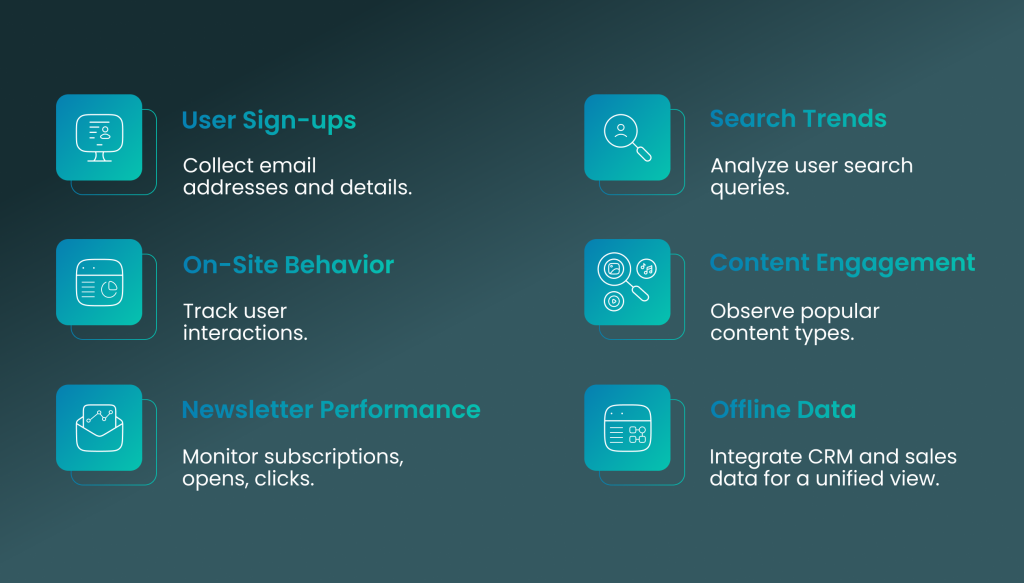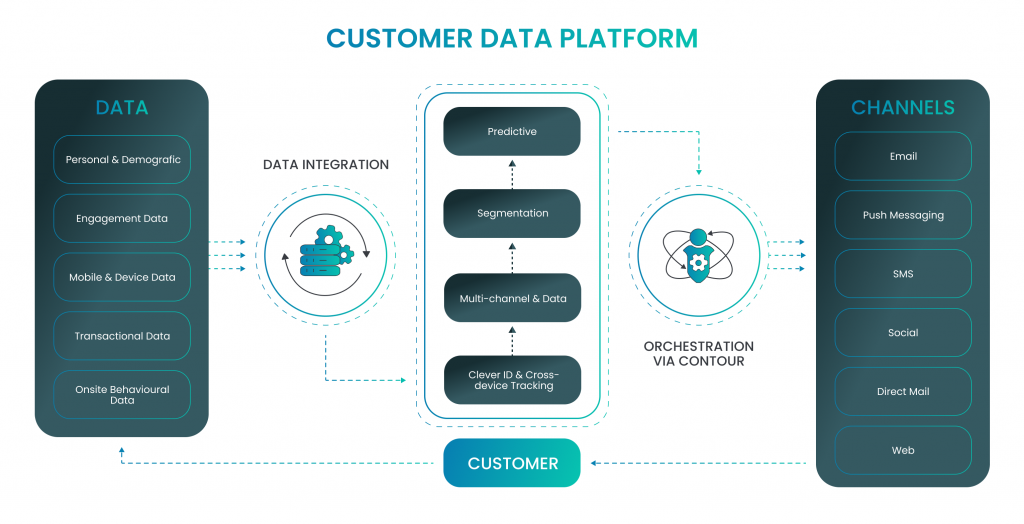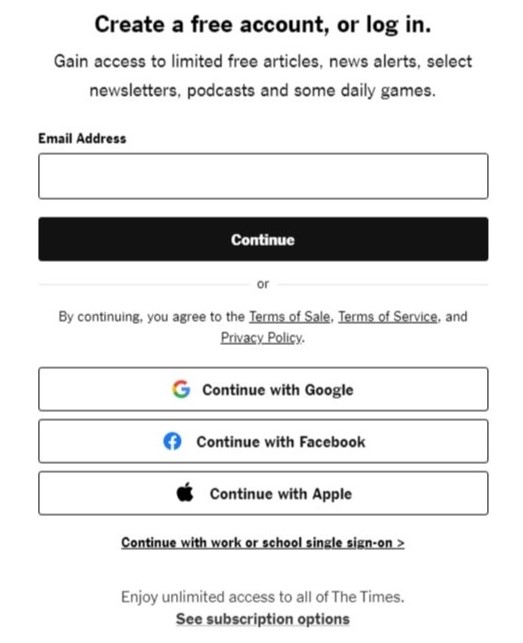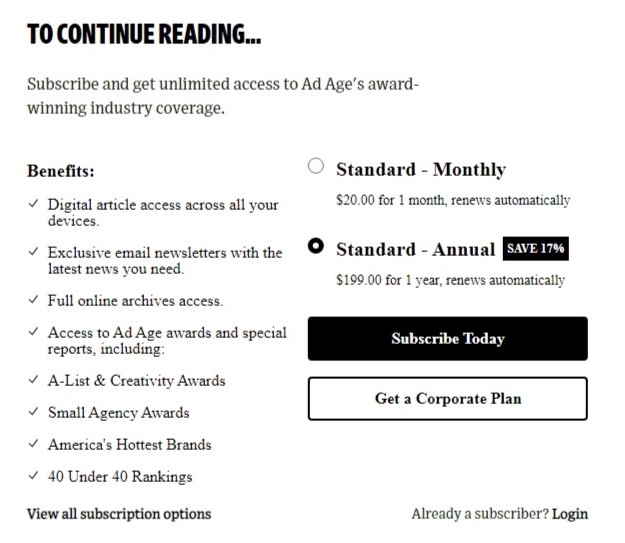As the world edges closer to privacy-focused policies and heavily regulated data collection processes, the importance of first party data advertising has come to the fore. Publishers, including those in the retail media space, can achieve higher yields and leverage their first-party data with comprehensive AdTech software development and ad monetization strategies. In addition to complying with privacy regulations, it enables publishers to build long-term customer relationships and establish trust, leading to increased loyalty and stable revenue.
This article delves into how publishers can benefit from first party data activation to navigate the current uncertainties and drive increased revenue for their businesses in the long run.
But first, let's take a quick look at why publishers transition from focusing on third-party to first-party data and reconsider their data collection strategies. We'll also recap the concept of first-party data and explore its examples.
Why Publishers Readjust Their Data Collection Approach
Google initially promised to phase out third-party cookies by the end of 2024 to enhance user privacy and comply with growing regulatory pressures. However, recent updates indicate ongoing adjustments to this timeline, reflecting the complexities of balancing privacy with industry needs.
Instead of removing third-party cookies from its Chrome browser on a due date, the tech giant has decided to give users an informed choice about their data privacy while browsing the web, as stated in a recent Privacy Sandbox news update.
The future of digital marketing is moving toward a privacy-first model, so while marketers can still use third-party cookies for now, they need to begin adapting to this new reality:
- Collect data directly from customers with explicit consent;
- Refine data collection methods by making the most of first-party data;
- Improve targeting by incorporating deterministic and probabilistic addressability solutions, etc.
The discussed shift stresses the importance of questioning, "Why is first party data important?" as traditional methods of targeting through third-party cookies will change.
What is First Party Data in Marketing?
Among the first party data examples, we can find:
- Demographic information;
- Preferred communication channels;
- Emails or phone numbers of registered users;
- Customer feedback;
- Data in a CRM;
- Survey data;
- Transactional data;
- Purchase history;
- On-site behavior data;
- Device types;
- Transcripts from online chats, etc.

First-party data is invaluable because it is collected directly from the user. It offers high accuracy and relevance, crucial in the evolving landscape of data privacy and user trust.
Second- and third-party data differ in their collection methods, accuracy, quality, and the presence of user consent:
| Benchmark | Second-party data | Third-party data |
|---|---|---|
| Source | Publisher’s trusted partner | External aggregators |
| Accuracy | Matches the accuracy of first-party data | Often less accurate due to aggregation from multiple sources |
| Collection process | Similar to first-party data but gathered by another organization | Aggregated from various sources, may lack direct user permission |
First-Party Data Collection: Where It Occurs
If you’re a publisher, chances are you’re already gathering first-party data, at least partially. Here are some of the most common sources:
- User registrations: Collecting email addresses and other details during sign-up.
- On-site analytics: Tracking how users interact with your website.
- Newsletter metrics: Monitoring subscription rates, open rates, and click-through rates.
- Inbound search patterns: Understanding what users are looking for on your website.
- Content consumption: Observing which types of content users engage with.
- Offline data: Utilizing CRM and sales data for a single view of user details, etc.

Publishers can rely on manual methods of 1st party data collection or use a Customer Data Platform (CDP). A CDP is an AdTech platform that aggregates, organizes, and analyzes data from different sources, helping publishers create detailed customer profiles and deliver personalized experiences across channels.

Then, engage our experienced AdTech development company. Let us help you develop a custom CDP solution and drive your audience engagement to new heights.
How Publishers Can Capitalize on First-Party Data
1. Personalize content
1st party data collection is a powerful tool for personalizing content because it allows businesses to learn about user preferences and behaviors directly.
When first-party data is collected and analyzed properly, it allows businesses to:
- Segment audiences into distinct groups based on unique characteristics and behaviors.
- Develop detailed buyer personas that reflect the preferences and needs of different user segments.
With segmented audiences in place, publishers can:
- Identify high-converting and highly engaged user profiles representing the most valuable customers.
- Discover lookalike audiences — potential customers who share similar behaviors and preferences with top-performing users.
- Predict future behavior within these segments, allowing businesses to project what users might like or how they might act.
Next, first-party data can be fed to recommendation systems. This step helps businesses to:
- Incorporate previous user interactions and purchase history to tailor content and product recommendations.
- Deliver personalized offerings that resonate with each user's preferences, enhancing the overall website experience.
- Increase conversion rates, as recommendations are more likely to align with the individual user's needs and interests.
2. Optimize ad inventory
Publishers can channel collected 1st party programmatic data into new revenue streams by optimizing their ad inventory and implementing flexible pricing models.
Here’s a quick overview of these strategies:
- Premium ad placements.
As we already mentioned, first-party data helps publishers pinpoint their most engaged user segments. By focusing on these high-performing audiences, they can offer premium ad placements that justify higher CPMs. This approach boosts ad inventory value and makes it easier for publishers to convince advertisers to pay higher prices.
- Dynamic pricing models.
First-party data allows publishers to set dynamic prices for their ad inventory. They can adjust ad rates in real-time based on engagement level and the quality of the audience visiting their website or app. Eventually, advertisers become more eager for premium access to high-quality traffic, which leads to better outcomes for publishers.
3. Enhance Audience Extension (AudEx)
Publishers can use first-party data to enhance Audience Extension (AudEx) and unlock new revenue opportunities. Here’s how:
- Data licensing. Publishers can license anonymized first-party data to advertisers for more precise targeting. This move helps avoid sharing complete datasets or Personally Identifiable Information (PII). The value of first party data enables advertisers to reach highly relevant audiences, which translates to new revenue streams for publishers.
- Off-site audience extension. Enable advertisers to retarget your audience beyond your own properties. With deep knowledge of their user segments, advertisers are keen to use their data to target other platforms, maximizing their campaign reach and precision.
- Lookalike audiences. Publishers can create lookalike audiences using their first-party data. By analyzing user demographics, behaviors, and engagement metrics, media sellers can identify the key attributes of their most valuable users.
4. Boost user retention and engagement
1st party data activation can be a publisher’s exclusive asset for refining user engagement and retention strategies.
Here are common tactics that involve the use of first-party data for addressing issues with low retention and engagement rates:
- Identify disengaged users. Analyze first-party data to find users who have become less active or disengaged.
- Personalize content. Reconnect with inactive users by delivering custom content or exclusive offers based on their interests and past behaviors. For example:
- Email re-engagement campaigns: Send personalized emails to restore their interest.
- In-app notifications: Use push notifications to remind users of what they’ve been missing.
- Retargeting ads: Show social media ads to previously interested users.
- Craft efficient loyalty programs.
- Publishers can use first-party data to track how often users engage with their content and offer rewards based on their level of interaction.
- An alternative is a tiered rewards system that encourages ongoing participation. Publishers can offer different levels of rewards that users can unlock based on their engagement.

See how predictive analytics can transform your retention strategy. Discover Geomotiv’s contribution to the project, which helped proactively identify and re-engage at-risk players.
5. Monetize data
Publishers can capitalize on their first-party data to generate revenue through targeted and programmatic advertising pipelines. Here's how to do it:
- Targeted advertising. The easiest way to monetize first-party data is by letting advertisers run their tailored campaigns through self-serve platforms. They can provide detailed audience segments by feeding the data into a Data Management Platform (DMP). These segments help advertisers zero in on the groups most likely to be drawn by creatives, making their campaigns efficient.
- Programmatic advertising. A further step is to tie first-party data into programmatic advertising platforms, which automates the ad-buying process:
- Private Marketplace (PMP) deals. Offering audience segments in a Private Marketplace lets advertisers bid on premium ad space. This step improves targeting and allows publishers to request higher CPMs.
- Programmatic Guaranteed deals. Publishers can offer programmatic guaranteed deals for advertisers who want more predictability. These deals lock in a fixed price for inventory. The added benefit is using programmatic advertising first party data to ensure ads reach relevant audiences.
Then, contact our AdTech development team for expert assistance in configuring and managing your programmatic advertising strategies.
6. Improve measurement and analytics

Another element of the strategy is employing the potential of first-party data to enhance analytics capabilities.
Here are a few tactics that utilize first-party data to improve the analysis of campaigns and strategies:
- Cross-channel analytics.
One of the benefits of first party data is the ability to follow user interactions across multiple channels, including:
- website;
- app;
- email newsletters;
- other platforms.
By consolidating data from these sources, publishers get a single view of the audience's journey, making it easier to understand user behavior and refine strategies.
- Performance metrics.
First-party data contributes to the detailed measurement of KPIs relevant to current and future business goals. For instance, publishers can track metrics like:
- user engagement,
- time spent on a page,
- click-through rates,
- conversion rates, etc.
7. Improve compliance and gain trust with audiences
Publishers must know how to collect first party data securely. Luckily, numerous ready-made frameworks help cover that necessity. Media sellers should also provide complete transparency into first-party data practices to nurture strong relationships with audiences:
- Manage privacy. Publishers must communicate to users how and why data is collected and align with privacy regulations, such as GDPR and CCPA.
- Collect user consent. First-party data collection should involve explicit user consent, typically through intuitive consent banners or opt-in forms.
- Collect minimum data from users. Publishers must process only the required data to improve targeting or content quality.
- Provide the right for users' data to be forgotten. Data practices should allow users to request the deletion of their data at any time.
- Implement robust security measures. Proper encryption protocols and access control systems should be in place to protect sensitive data.

8. Develop efficient subscription and paywall models
First party data targeting practices can go beyond tweaking ad campaigns to the needs of user groups and buyer personas. They also extend to developing other revenue sources, including tailored subscription offers and paywalls.
Publishers can use insights generated from analyzing first-party data to offer customized subscription packages:
- personalized newsletters;
- content bundles on specific topics, etc.
Media sellers can adjust their strategy for paywall, a.k.a. gated content, by implementing adaptive subscription models. For instance, users who regularly engage with premium content will be matched with subscription offers that match their interests and preferences.




9. Ensure cross-platform consistency
In today's world, it's common for users to switch between devices and platforms and expect a seamless experience. Thanks to 1st party data activation, publishers can take the transition between devices to the next level. These data-driven strategies can help:
- Unified user experience.
First-party data lets publishers identify and recognize users across devices, whether browsing the content via smartphone, tablet, desktop, or CTV. Universal IDs help a lot in this regard. Unlike conventional cookies, which are limited to a single browser or device, Universal IDs provide a consistent and unique identifier for each user.
- Cross-device targeting.
First-party data contributes to precise cross-device targeting, ensuring users receive consistent messaging across all platforms. Publishers can tailor their content to each platform's needs and contexts by understanding how consumers interact with devices. This approach maximizes engagement and keeps users connected to the brand, no matter their device.
10. Build partnerships and collaborate
Rather than isolating first-party data monetization strategy, publishers can consider joining forces with other industry players.
Spotify, for example, shared its first-party intelligence with WPP, an international PR, advertising, and commerce holding company. By integrating Spotify's accurate audience data into its insights tools, WPP can help its clients create more targeted digital audio ads.
Collaboration with other publishers, advertisers, or data platforms helps explore what interests and engages target audiences from diverse angles. Here's how:
- Through data partnerships.
Other publishers or data platforms can share their audience behavior and preferences findings. By collaborating, publishers will combine their first-party data sets with new information. As a result, they can enhance their targeting capabilities and expect better outcomes of marketing efforts.
- Through collaborative ad campaigns.
Sharing first party data audience segments with advertising partners helps create customized campaigns tailored to specific customers. This approach boosts campaign relevance and performance and demonstrates the strategic value of the collected data.
Final Word
As we transition into a first party data cookieless world, publishers can leverage the data directly collected from their audiences. By developing a comprehensive first-party data strategy, they can enhance their targeting capabilities, improve user experiences, and drive revenue. This practice also aligns with evolving privacy regulations and helps media sellers build stronger partnerships and develop more efficient strategies.
To fully capitalize on first-party data, publishers should stay informed about the latest trends and technologies, including AI and Machine Learning, to continuously refine their strategies and stay ahead of the competition.
Then, contact our experienced AdTech consultants. We’ll help you create a fully custom first-party data programmatic advertising strategy and provide technical support with its orchestration and implementation.






